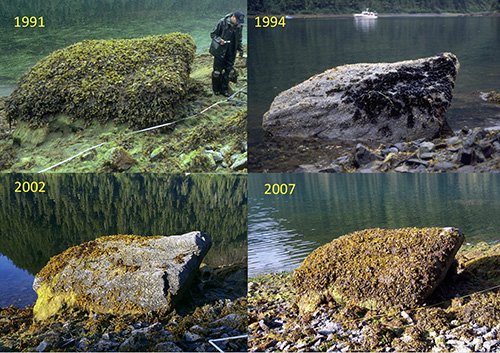Monitoring and Visualizing an Ecosystem’s Recovery after a Catastrophic Oil Spill
JULY 17, 2023 — NOAA scientists, aided in recent years by citizen scientists, have been photographing a boulder in Prince William Sound for 33 years. Why? The rock was coated in oil in 1989 when the Exxon Valdez supertanker ran aground on Bligh Reef, dumping more than ten million gallons of crude oil into the Sound. Today, the boulder is known as Mearns Rock, nicknamed after Dr. Alan Mearns, a scientist emeritus in NOAA’s Office of Response and Restoration.

During the spill cleanup, response crews power-washed oil off shorelines into the ocean, where it was easier to corral. But the effort also ripped away marine life. While some sections of the coast were treated, others, like Mearns Rock, were left oiled.
For the next decade, Dr. Mearns and a team of chemists and biologists returned to the rock and dozens of other sites in the region to assess the ecosystem’s recovery from oil exposure and power washing. This multi-year monitoring effort also captured the changes Mearns Rock underwent through the years with photos. Most recently, a photo of Mearns Rock from July 1, 2023 has just been added to the series.
The primary purpose of the photo series has been to provide the public, responders, and others with visual presentation showing how much the intertidal ecosystem changes from year to year; but it is also an effort to measure and establish a baseline of variability. Some years, the rocks are covered in mussels; other years, in seaweeds; and still other years, in barnacles. The repeated photos (which extend way beyond the 3-4 year "recovery" period) show natural oscillations in which species dominate the abundance (or cover) of marine life. The relevance is that these oscillations make it difficult, if not impossible, to determine when the biology has recovered—unless they are accounted for.
In his report, Twenty-Five Years After the Exxon Valdez Oil Spill: NOAA’s Scientific Support, Monitoring, and Research, NOAA scientist Gary Shigenaka shows, statistically, how this year-to-year variability was accounted for during the Exxon Valdez recovery years (1990s). Similarly, the Mearns Rock section of Oil in the Sea IV: Inputs, Fates, and Effects (pages 298-299) shows, visually and graphically, the extent of these variations.
The photo-monitoring work of volunteer citizens and scientists continues to define the range of variability of rocky intertidal marine life, enabling us to better understand recovery.
